|
|
|
|
| Missing In Action (MIA) | Prisoners Of War (POW) | Unexploded Ordnance (UXO) |
| Chronology | Locations | Aircraft | Ships | Submit Info | How You Can Help | Donate |
|
 5th AF October 24, 1942 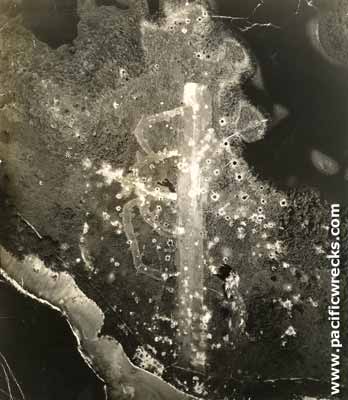 38th BG May 13, 1943  43rd BG May 21, 1943  5th AF Sept 9, 1943 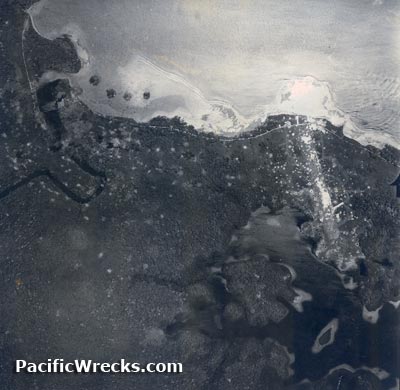 90th BG Nov 21, 1943 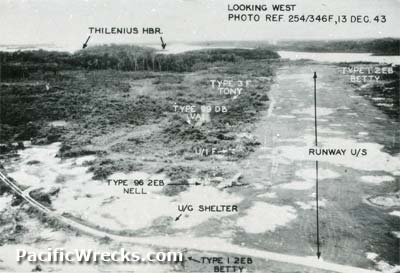 5th AF Dec 13, 1943  Edwards April 13, 1944   Ray Fairfield 1972  1979 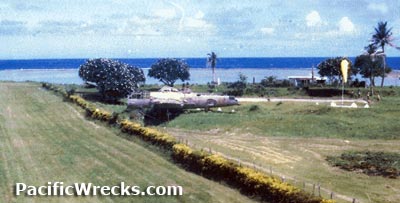 Brian Bennett 1981 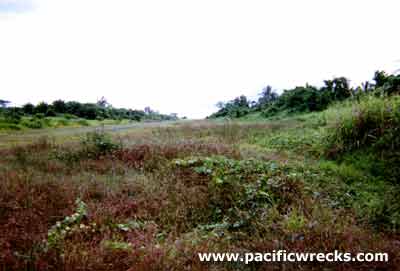 John Douglas 1996 |
Location Lat 6° 16' 60S Long 150° 19' 52E Gasmata Airfield is located at Gasmata on the southern coast of New Britain. Borders Thilenius Harbor (Gasmata Harbor) to the northwest. The Japanese referred to this location as Surmi, Surumi or Tsurumi. Also spelled "Gasmatta". Today located in West New Britain Province in Papua New Guinea (PNG). Construction Prewar, a single grass surfaced runway was built at this location by an Australian civilian contractor to for the nearby copra plantation. Wartime History During the night of February 8-9, 1942 Gasmata Airfield was occupied by the Japanese Navy No. 2 Maizuru Special Naval Landing Force (SNLF). Afterwards, the runway was expanded for use as a forward operating base for the Imperial Japanese Navy (IJN). On February 11, 1942 four A5M4 Claude fighters from Chitose Kōkūtai (Chitose Air Group) arrived as the first Japanese fighters to operate from Gasmata Airfield. That same day, the four Claudes intercepted the first Allied air raid against Gasmata when three Royal Australian Air Force (RAAF) Hudsons attacking ships in Thilenius Harbor and shot down Hudson A16-126 (MIA) and Hudson A16-91 (2 KIA, 2 survived). Soon afterwards their unit was renamed the 4th Kōkūtai (4th Air Group). The Japanese never permanently stationed planes at Gasmata on any permanent basis. During 1942, fighters based here for short periods. Japanese fighters and bombers landed at this location when short on fuel or to make force landings when returning from missions. Japanese units that operated from Gasmata Airfield Imperial Japanese Navy (IJN) Chitose Kōkūtai (Chitose Air Group) / 4th Kōkūtai (4th Air Group) (4 x A5M4) February 11, 1942 253 Kōkūtai (253 Air Group) (A6M Zero) February 1943 Mihoro Kōkūtai (Mihoro Air Group) (G3M2) Kanoya Kōkūtai (Kanoya Air Group) (G3M2) Tainan Kōkūtai (Tainan Air Group) (A6M2) Japanese Army Air Force (JAAF) 76th Dokuritsu Dai Shijugo Chutai (76th Independent Squadron) (Ki-46) Gasmata Airfield was targeted by Allied planes with the first air raid on February 11, 1942 and subjected to bombing and strafing missions by the Royal Australian Air Force (RAAF) and U.S. Army Air Force (USAAF) until early 1944. Allied missions against Gasmata Airfield February 11, 1942–March 28, 1944 During March 1943, Gasmata Airfield was as a staging base to support "Operation 81" that resulted in the Battle of the Bismarck Sea. During Operation I-Go on April 14, 1943 two G4M1 Bettys one from the 705 Kokutai and the other from the 751 Kokutai force landed at this location. From May 1943 onward, Gasmata was subjected to heavy bombing and not used thereafter for by the Japanese for flight operations. Instead, the Japanese built Hoskins Airfield on north coast of New Britain as an alternative airfield. During the middle of 1943, Gasmata Airfield was abandoned by the Japanese. As of October 23, 1943 the single runway was 3,200' with taxiways to the side of the strip, defended by light anti-aircraft guns. Two nearby jetties serviced the strip from the north and west sides of the peninsula. On January 13, 1944 photograph intelligence showed nine light anti-aircraft guns in Ring Ring village to the northeast and 50 fighter dispersal revetments. On March 17, 1944 PT-143 entered Thilenius Harbor and tied up to the jetty at Gasmata Airfield and members of the crew went ashore and found the area abandoned by the Japanese. By March 28, 1944 Australian Army patrols reached Gasmata Airfield and found it abandoned. In the middle of April 1944 a U.S. patrols visited Gasmata Airfield and removed mines from the runway. Japanese aircraft wreckage abandoned at Gasmata List of Japanese aircraft abandoned at Gasmata. Afterwards, the Allies never repaired the runway and it was disused. Brian Bennett adds: "I first saw the aircraft at Gasmata in the middle of 1972. There were more bits of wreckage around the place in those days. I recall that there were besides the main and near complete wreck of the G3M the partial wreckage of two others. The wreckage of 5 Zero's not including the example that was cut up and removed to Port Moresby and later restored by the RAAF and now in AWM. The wreckage of a bombed out G4M1 Betty in a large bomb hole further west along the strip. I tried very hard back in the late 70's and again in the 80's to get something done about saving the Ki-46 and the G3M but to no avail." Douglas Hubbard, Jr. adds: “I personally acquired title to [Zero 5784 and Val 3105] from the PNG government in the middle of 1973. It was formerly deeded to the Australian people as a gesture of goodwill and appreciation for the assistance provided in recovery of the D3A2 Val 3105 I recommended that the Zero be donated to the AWM, and was instructed to effect the transfer, which I did via the senior RAAF officer at Murray Barracks. He elected not to take the Zero out at the time when shipped the Val, preferring he said, Their air frame fitters disassembled the plane and flew it out of Gasmata via RAAF Caribou." John Douglas adds: "I visited in 1992, I did talk to the local people, who said that some wrecks were dragged in from the outer areas to make a sort of display, a few vehicles as well. Gasmata is an abandoned logged over area with a few rural roads that go nowhere. Several stories of good plane wrecks in the waters around the area as well. Lovely diving and fishing too." Today Still in use today as "Gasmata Airport" or "Gasmata Island Airport". Airport code: IATA: GMI. Serviced by secondary airlines, charter and missionary aircraft. References Ken’s Men Against The Empire Volume I: Prewar to October 1943 The B-17 Era (2020) pages 39, 54, 60, 85, 93-95, 98, 101-103, 110, 111, 117, 128, 133-136, 138, 154-157, 163, 164, 166, 167, 177, 180, 193, 194, 197 (May 17, 1943), 201, 202, 206, 207, 211, 213, 227, 239, 249, 297, 303, 304, 326, 338, 360, 364-366, 372, 379-381, 401 (index Gasmata) Contribute
Information Last Updated
|
Map Fallingrain Photo Archive |
| Discussion Forum | Daily Updates | Reviews | Museums | Interviews & Oral Histories |
|